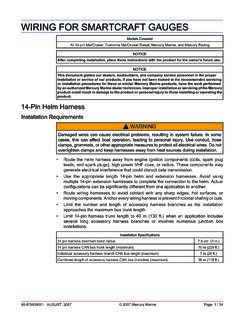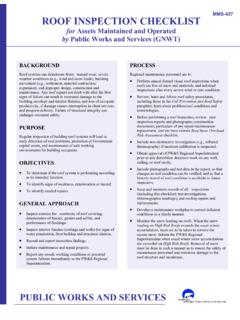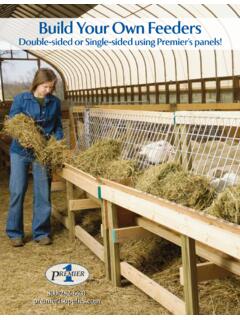Transcription of Correct procedure for flange bolting Installation Procedure
1 Correct Procedure for flange bolting Installation Procedure The most common cause of leaky gasket joints is improper Installation procedures . Care shall be taken at all stages given below. Cutting of Soft Gaskets First cut / punch bolt holes. Cut the bolt holes slightly larger than the bolts, to ensure proper seating. Never cut out a gasket by hammering material against the flange . Use a good cutter to cut the required shape of the gasket. Ensure that the inside diameter of the gasket is not less than the inside diameter of the process line to minimize obstruction of the process line. Handling of Gaskets When working in the field, carry cut gaskets carefully. If you bend the gasket it will be damaged.
2 Always transport large diameter metallic and semi-metallic gaskets to the Installation site on its mounting / packing. Tools Required and Cleaning Tools will be required to both clean the flange and tension the fasteners. Clean fasteners with a wire (ideally brass) brush to remove dirt on the threads. After removing old gasket, clean flange surface of all debris using a wire brush (use stainless steel bristles on alloy components) or a brass scraper (a scraper can be made from a sheet of brass, ~5 mm ( in) thick x 50 mm (2 in) wide, which is filed and shaped to a 45 chisel across the width). Using a hammer, lightly tap the scraper into the flange grooves to remove debris. flange spreaders may be used to make gap between flanges for cleaning them.
3 Two spreaders are required for a joint. Use mechanical / hydraulic type spreader based on force required to open flanges. The tensioners will require regular calibration and may include torque wrench, hydraulic or other tensioners. Instruments to measure tension may include a micrometer, or Ultrasonic equipment. Visual Inspection Inspect various components as under. Fasteners / nuts / washers after cleaning examine them to assure freedom from defects such as burrs or cracks. flange assembly inspect the flange surfaces for defects, such as radial scores and warping. Ensure that the flange surfaces are sufficiently flat and parallel. Gasket check that the Correct gasket is available (suitable for the service, size, thickness).
4 Examine the gasket prior to Installation to ensure that it is free from defects. If any defect is observed, replace defective components with a good alternative. Lubrication It is estimated that in the absence of a suitable lubricant, up to 50% of the torque effort may be used to merely overcome friction. Effectively, this would mean that the same torque applied to non-lubricated fasteners on a joint might provide markedly different loads on each one. Therefore, lubrication is essential when torque is used as the control for setting tension in the joint. After cleaning, lubricate fastener threads and all bearing surfaces (underside of bolt heads, nuts, washers) with a quality lubricant such as an oil and graphite mixture.
5 Ensure that lubricant does not contaminate either flange or gasket faces. Gasket Installation Carefully insert the new gasket between the flanges to prevent damage to the gasket surfaces and center it. Do not use tape to secure the gasket to the flange . If it is necessary to secure the gasket to the flange , use a light dusting of spray adhesive ( 3M type 77). Do not use jointing compounds or release agents on gasket / flange faces. Bolt / Stud Tightening Pattern One of the most difficult jobs is to produce the Correct assembly pressure on the gasket, low enough to avoid damaging the gasket, but high enough to prevent a leak in the seal. It is vitally important to control accurately the amount of force applied to any particular flange arrangement.
6 Always use a torque wrench or other controlled-tensioning device for tightening. The sequence in which bolts or studs are tightened has a substantial bearing upon the distribution of the assembly pressure on the gasket. Consequently always torque nuts in a cross bolt tightening pattern. Always run the nuts or bolts down by hand. This gives an indication that the threads are satisfactory (if the nuts will not run down by hand, then there is probably some thread defect check again and, if necessary, replace defective parts). Now torque the joint using a minimum of 5 torquing passes, using a cross- bolting sequence for each pass, as shown below. Pass 1 Tighten nuts loosely by hand in the first instance, according to the cross bolt tightening pattern, then hand-tighten evenly.
7 Pass 2 Using a torque wrench, torque to a maximum of 30% of the full torque first time around, according to the cross bolt tightening pattern. Pass 3 Torque to a maximum of 60% of the full torque, according to the cross bolt tightening pattern. Pass 4 Torque to the full torque, according to the cross bolt tightening pattern. Pass 5 Final pass at full torque, in a clockwise direction on adjacent fasteners. After the five basic torquing passes are completed, it may be beneficial to repeat pass 5 until no further rotation of the nut is observed. The final tightening must be uniform, with each bolt pulling the same load. Hydraulic tensioners are often used to preload fasteners. In this method when the tensioner load is applied, the nut is run down against the joint (finger tight).
8 The hydraulic pressure is then released and the tensioner removed. Another way to tighten large bolts is to insert a heating rod in a hole drilled down through the centre of the bolt. As it heats up, the bolt expands length wise, and the nut can be run down against the joint (finger tight). The heater is now removed, and as the bolt cools, it shrinks, so developing tension. Re-tightening For the majority of materials in the flange system (including gaskets, fasteners, nuts, washers), relaxation sets in after a fairly short time. For soft gasket materials, one of the major factors is usually the creep relaxation of the gasket. These effects are accentuated at elevated temperatures. Due to this the compressive load on the gasket is reduced, increasing the possibility of a leak.
9 Consequently, some engineers recommend that fasteners should be re-tightened (to the rated torque) 24 hours after the initial assembly. Re-tightening shall always be carried out at ambient temperature. However, this is an area of conflicting views! Elastomer-based CAF gasket materials continue to cure in service, especially on start up as the operating temperature is reached. Once fully cured, gasket materials may become embrittled and liable to cracking under excessive load, and this is especially the case with elastomer-based asbestos-free materials. As it is impossible to predict the time for embrittlement, always consult the manufacturer for advice about re-tightening. As a general rule do not re-torque an elastomer-based asbestos-free gasket after it has been exposed to elevated temperatures.
10 Storage of Gaskets Although many gasket materials can be used safely after storage for many years, ageing will have a distinct effect on the performance of certain types of gasket materials. Primarily, this is a concern with materials which are bonded with elastomers. They in general should not be used after about 5 years from the date of manufacture. If required, they shall be used only after careful inspection. Materials with elastomeric binders will inevitably deteriorate over time, and even more quickly at higher ambient temperatures. Degradation is also catalysed by intense sunlight. Since graphite and PTFE materials contain no binders, sheets and gaskets of these materials have a virtually indefinite shelf life.








